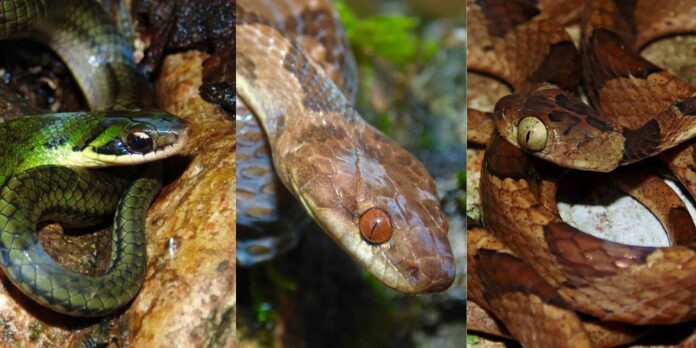With approximately 800 species found in South and Central America, dipsadine snakes constitute one of the most remarkable vertebrate radiations ever in a continental setting. Their species richness matches their incredible ecological diversity, ranging from terrestrial generalists to aquatic eel-eating specialists and arboreal snail-eating specialists.
Though this clade is essential from an ecological standpoint, little is known about how much larger patterns of phenotypic diversity within the group are shaped by ecological specialization.
By studying the skull shapes of dipsadine snakes, researchers at The University of Texas at Arlington have found how these species of snakes have evolved and adapted to meet the demands of their habitats and food sources.
Gregory Pandelis, collections manager at UTA’s Amphibian and Reptile Diversity Research Center, said, “We now have evidence that this group of snakes is one of the most spectacular and largest vertebrate adaptive radiations currently known to science. We found that habitat use and diet preferences strongly correlate to skull shape in this group of snakes, indicating these are likely factors driving cranial evolution for these species.”
Because skull shape has significant functional effects on snakes, including prey capture and ingestion, habitat utilization, partner choice, and predator defense, scientists focused on the evolution of snake skulls. Since snakes lack limbs, their heads are essential for moving through their environment, and capturing and consuming prey considerably larger than their bodies would indicate is feasible.
Using X-ray microcomputed tomography-scanning technology (CT scanning) on preserved museum specimens, scientists constructed 3D digital reconstructions for the skulls of 160 species of dipsadine snakes to study the development of skull form. Then, to investigate the connection between skull shape and ecology, they used geometric morphometrics to quantify their shape and combined it with the information they gathered in the field about the diet and lifestyle of these snakes.
Pandelis said, “Our research shows that snakes that are aquatic (water) or fossorial (underground dwellers) seem to have the strongest selective pressure on their skulls, and evolutionary convergence is rampant among these groups.”
“There are only a few good evolutionary solutions to the difficult problems of efficiently moving through dirt and water. This study provides important insights into how snakes adapt to their highly unique ways of eating and inhabiting their environments. However, there is much that we still don’t know about these enigmatic and fascinating animals.”
Journal Reference:
- Gregory G. Pandelis, Michael C. Grundler & Daniel L. Rabosky. Ecological correlates of cranial evolution in the megaradiation of dipsadine snakes. BMC Ecology and Evolution. DOI: 10.1186/s12862-023-02157-3
